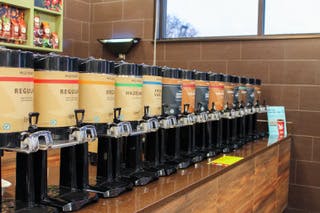As consumers stayed home from work and school, convenience store sales in the U.S. declined by an estimated 9% in 2020, according to market research company Mintel. However, the picture was different in the U.K., where lockdown drove customers to shop locally in smaller stores, with 64% of Britons buying close to home, according to recent research from Barclaycard Payments.
Coresight Research Inc. in London estimates that c-store sales increased at a mid-single-digit pace in 2020 versus a low-single-digit increase in prior years. Urban and transit locations took a negative hit, while customers piled into neighborhood stores. John Mercer, head of global research at Coresight, expects the former to pick back up as consumers return to normal life. At the same time, he thinks c-store sales overall will drop, as shoppers return en masse to supermarket shopping.
What do shoppers want?
Sales in American stores are not expected to recover until 2022, meaning operators need to keep on their toes to offer exactly what shoppers are looking for.
But what is that exactly?
Grocery products and health and beauty items helped keep c-stores afloat during the pandemic as shoppers sought toilet paper, sanitizer, and other essentials wherever they could find them, as well as CBD products (from gummies to beverages and topicals), which were already starting to do well before the arrival of COVID.

“People who used c-stores in the past may not have used them much for grocery and HBC but now that they’ve used them during COVID, they do now,” says Bill Nolan, partner, The Business Accelerator Team, a convenience store consulting firm in Phoenix, Ariz. “So you’ll likely see a continued lift in those sections.”
Categories like OTP (Other Tobacco Products), packaged beverages and beer, wine, and spirits will continue to be as strong as ever, but he also expects to see, “a lot of innovation coming out in the cold box.”
In the U.K., the traditional “fags and booze” (aka, cigarettes and alcohol) that make up about a third of sales in c-stores, are losing a little ground to items such as prepared foods. According to Coresight Research, like their American counterparts, Brits also regularly hit their c-stores for groceries, predominantly chilled foods, or “foods for tonight,” which customers would, in normal times, buy in a supermarket, says Mercer, as well as non-chilled fresh food.
Mimicking restaurants
For years c-stores have been upping their coffee game and there’s no time like the present to continue to push the envelope with gourmet options and bean-to-cup beverages. “Coffee’s going to continue to be a priority for c-stores to offer consumers the freshest product,” Nolan says. “Many c-stores can compete with any coffee house.”

Among foodservice, as well as continuing to offer better options, convenience stores are offering food that appeals to kids, according to a recent report, Convenience Store Foodservice, from Mintel, since Millennials, and especially dads, are heavy c-store users. East Coast chain Wawa launched its first kids’ meals last summer, priced from $3.99 to $5.99.
We expect it now from restaurants and it extends to convenience stores: Mobile ordering. More convenience operators who offer made-in-store food are allowing customers to order by app, then walk-in or drive by to pick it up. Delivery is often an option too, “because it’s part of the overall convenience,” says Nolan.
British shoppers are going about this slightly differently, and wanting their c-store goodies delivered to their home, usually through a third-party, Mercer explains. “Vendors offering smaller deliveries from their stores makes a lot of sense, driving additional sales at little to no incremental cost, given the markups and delivery charges on delivered orders,” he says.
Gaming is likely to become more popular in American convenience stores, Nolan believes, with some states starting to approve slot machines and video games. “It’s very good revenue,” he points out. He adds that gaming also turns stores into a destination and keeps people in the store longer. GPM Investments has installed machines in 60 Fas Mart, Apple Market, and Roadrunner Market stores in Virginia.

Most convenience stores have been offering loyalty programs for years but they’re getting more sophisticated and more appealing to consumers, Nolan says, with the more personalized deals, the better.
The convenience store market in the U.K. is driven by stores owned by the major supermarkets, which means customers can use their loyalty cards there. Tesco recently introduced Clubcard Prices — promotional price cuts on selected products for Clubcard holders — and extended this offer to its Express convenience stores, Mercer points out.
As we come out of the pandemic, I’ll keep shopping at my local convenience store; how about you?

